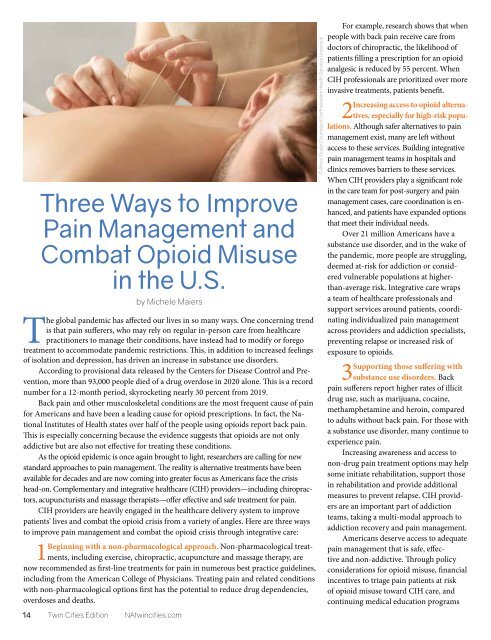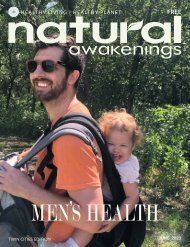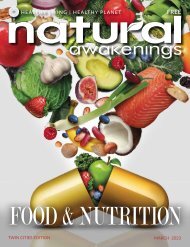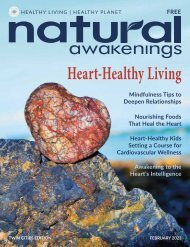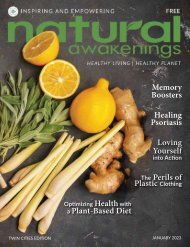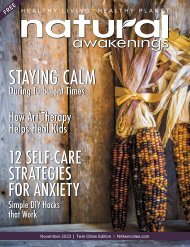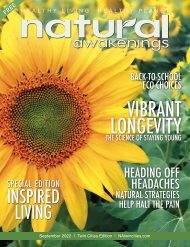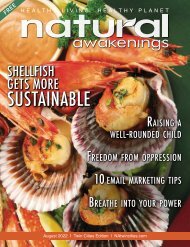Natural Awakenings Twin Cities September 2021
Read the September 2021 edition of Natural Awakenings Twin Cities magazine. This is our annual Inspired Living Issue which is focused on Creativity in Health and Healing and Integrative Pain Management. Topics also include the power of the written word, finding pain relief in essential oils, natural approaches to combating opioid abuse, creative kids, and so much more! Be sure to check out our local content including News Briefs announcements, Community Resource Guide with providers throughout the metro who can meet your individual wellness needs, and all the happenings in the Calendar of Events. There is additional online-only content that can be found at NATwinCities.com. While you are there, be sure to sign up for our Newsletter and Digital Magazine and continue your reading with our archived articles from local experts.
Read the September 2021 edition of Natural Awakenings Twin Cities magazine. This is our annual Inspired Living Issue which is focused on Creativity in Health and Healing and Integrative Pain Management. Topics also include the power of the written word, finding pain relief in essential oils, natural approaches to combating opioid abuse, creative kids, and so much more!
Be sure to check out our local content including News Briefs announcements, Community Resource Guide with providers throughout the metro who can meet your individual wellness needs, and all the happenings in the Calendar of Events. There is additional online-only content that can be found at NATwinCities.com.
While you are there, be sure to sign up for our Newsletter and Digital Magazine and continue your reading with our archived articles from local experts.
Create successful ePaper yourself
Turn your PDF publications into a flip-book with our unique Google optimized e-Paper software.
Three Ways to Improve<br />
Pain Management and<br />
Combat Opioid Misuse<br />
in the U.S.<br />
by Michele Maiers<br />
The global pandemic has affected our lives in so many ways. One concerning trend<br />
is that pain sufferers, who may rely on regular in-person care from healthcare<br />
practitioners to manage their conditions, have instead had to modify or forego<br />
treatment to accommodate pandemic restrictions. This, in addition to increased feelings<br />
of isolation and depression, has driven an increase in substance use disorders.<br />
According to provisional data released by the Centers for Disease Control and Prevention,<br />
more than 93,000 people died of a drug overdose in 2020 alone. This is a record<br />
number for a 12-month period, skyrocketing nearly 30 percent from 2019.<br />
Back pain and other musculoskeletal conditions are the most frequent cause of pain<br />
for Americans and have been a leading cause for opioid prescriptions. In fact, the National<br />
Institutes of Health states over half of the people using opioids report back pain.<br />
This is especially concerning because the evidence suggests that opioids are not only<br />
addictive but are also not effective for treating these conditions.<br />
As the opioid epidemic is once again brought to light, researchers are calling for new<br />
standard approaches to pain management. The reality is alternative treatments have been<br />
available for decades and are now coming into greater focus as Americans face the crisis<br />
head-on. Complementary and integrative healthcare (CIH) providers—including chiropractors,<br />
acupuncturists and massage therapists—offer effective and safe treatment for pain.<br />
CIH providers are heavily engaged in the healthcare delivery system to improve<br />
patients’ lives and combat the opioid crisis from a variety of angles. Here are three ways<br />
to improve pain management and combat the opioid crisis through integrative care:<br />
Beginning with a non-pharmacological approach. Non-pharmacological treatments,<br />
including exercise, chiropractic, acupuncture and massage therapy, are<br />
1<br />
now recommended as first-line treatments for pain in numerous best practice guidelines,<br />
including from the American College of Physicians. Treating pain and related conditions<br />
with non-pharmacological options first has the potential to reduce drug dependencies,<br />
overdoses and deaths.<br />
14 <strong>Twin</strong> <strong>Cities</strong> Edition NAtwincities.com<br />
“ © Africa Studio Courtesy of Northwestern Health Services University”<br />
For example, research shows that when<br />
people with back pain receive care from<br />
doctors of chiropractic, the likelihood of<br />
patients filling a prescription for an opioid<br />
analgesic is reduced by 55 percent. When<br />
CIH professionals are prioritized over more<br />
invasive treatments, patients benefit.<br />
Increasing access to opioid alternatives,<br />
especially for high-risk popu-<br />
2<br />
lations. Although safer alternatives to pain<br />
management exist, many are left without<br />
access to these services. Building integrative<br />
pain management teams in hospitals and<br />
clinics removes barriers to these services.<br />
When CIH providers play a significant role<br />
in the care team for post-surgery and pain<br />
management cases, care coordination is enhanced,<br />
and patients have expanded options<br />
that meet their individual needs.<br />
Over 21 million Americans have a<br />
substance use disorder, and in the wake of<br />
the pandemic, more people are struggling,<br />
deemed at-risk for addiction or considered<br />
vulnerable populations at higherthan-average<br />
risk. Integrative care wraps<br />
a team of healthcare professionals and<br />
support services around patients, coordinating<br />
individualized pain management<br />
across providers and addiction specialists,<br />
preventing relapse or increased risk of<br />
exposure to opioids.<br />
Supporting those suffering with<br />
3 substance use disorders. Back<br />
pain sufferers report higher rates of illicit<br />
drug use, such as marijuana, cocaine,<br />
methamphetamine and heroin, compared<br />
to adults without back pain. For those with<br />
a substance use disorder, many continue to<br />
experience pain.<br />
Increasing awareness and access to<br />
non-drug pain treatment options may help<br />
some initiate rehabilitation, support those<br />
in rehabilitation and provide additional<br />
measures to prevent relapse. CIH providers<br />
are an important part of addiction<br />
teams, taking a multi-modal approach to<br />
addiction recovery and pain management.<br />
Americans deserve access to adequate<br />
pain management that is safe, effective<br />
and non-addictive. Through policy<br />
considerations for opioid misuse, financial<br />
incentives to triage pain patients at risk<br />
of opioid misuse toward CIH care, and<br />
continuing medical education programs


